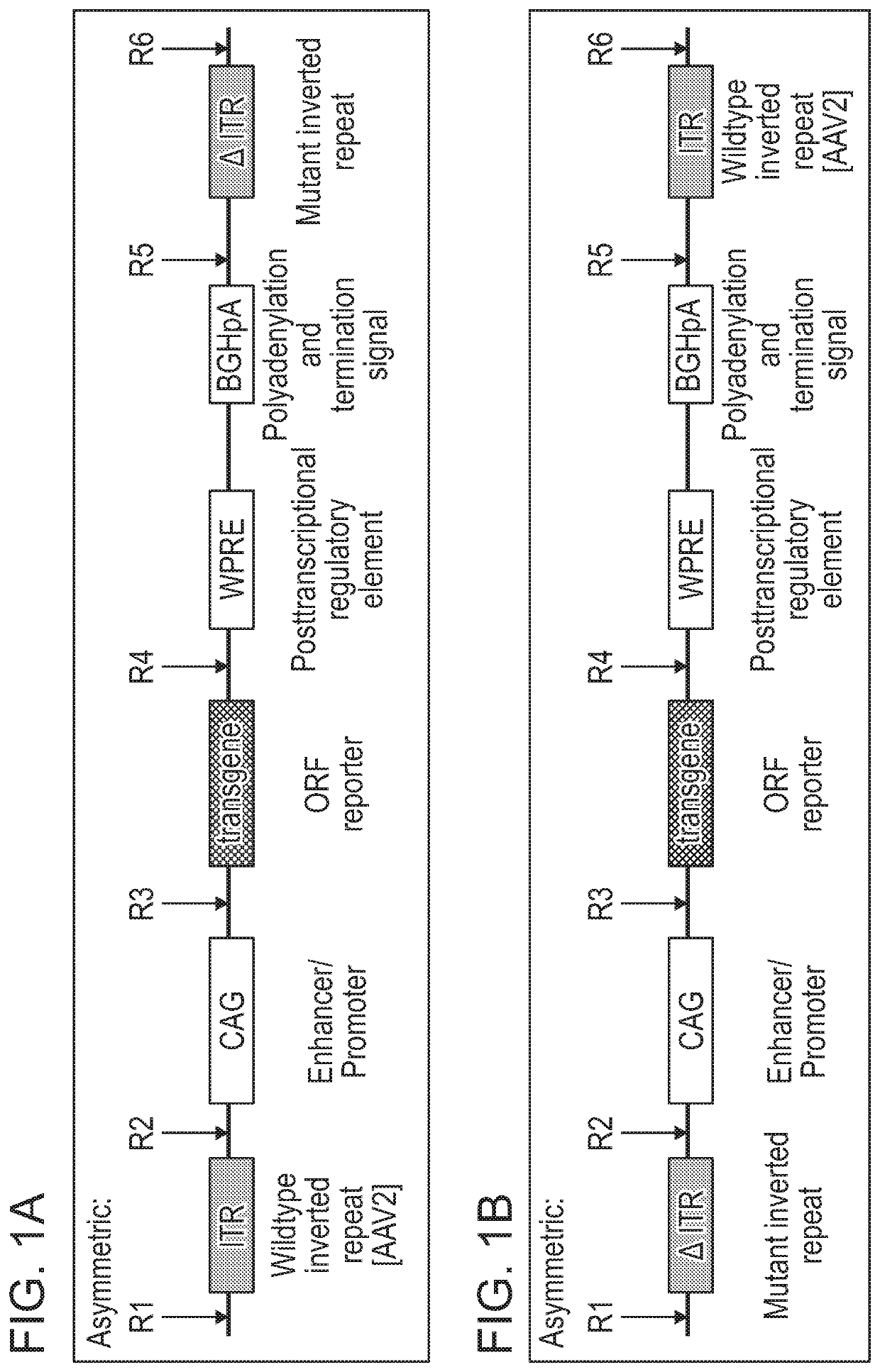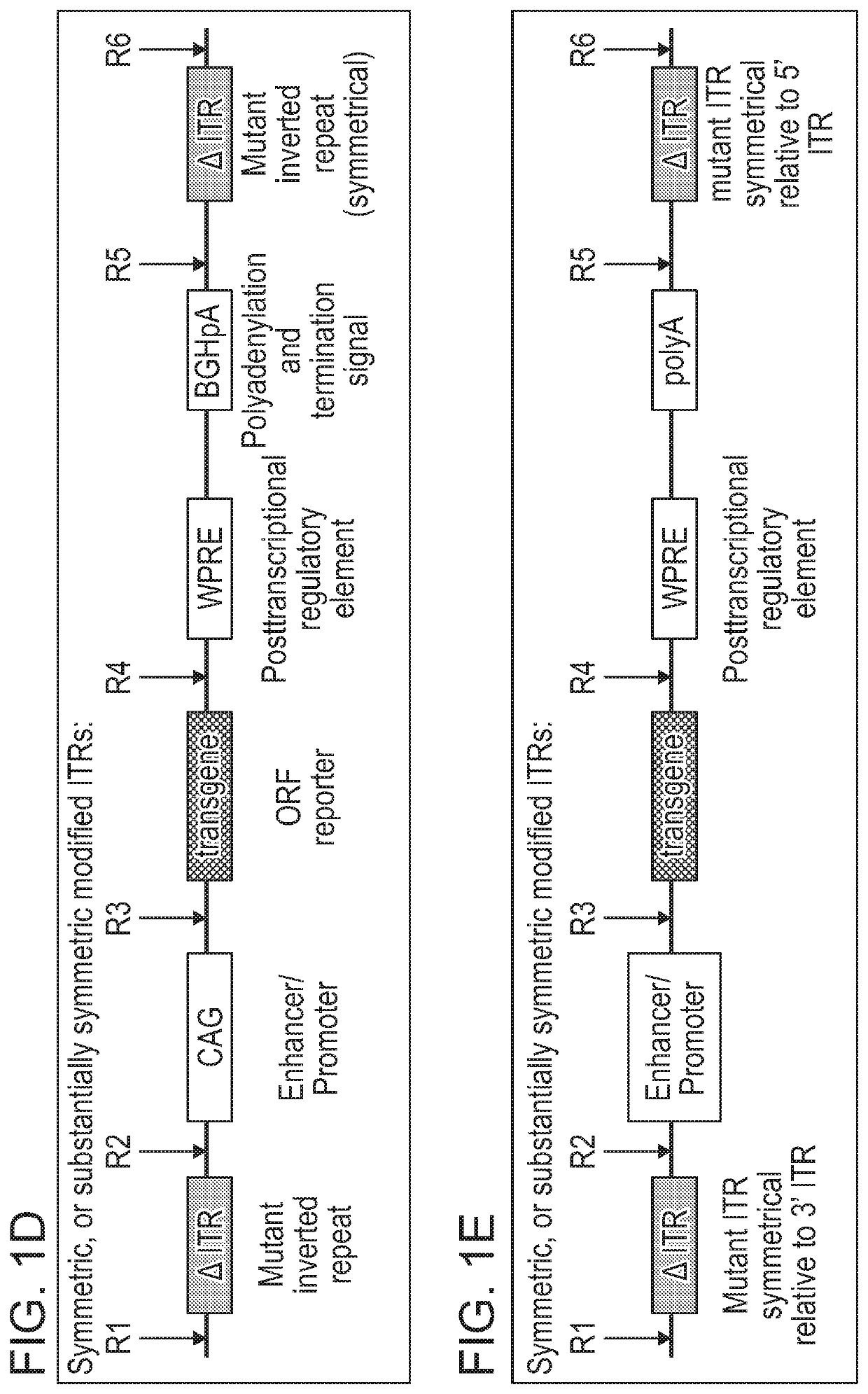Non-viral DNA vectors and uses thereof for expressing fviii therapeutics
a technology of fviii enzyme and dna vector, which is applied in the field of gene therapy, can solve the problems of limited viral packaging capacity, capsid immunogenicity, and limited use of aav vectors, and achieve the effects of rapid onset of therapeutic effect, sustained expression of corrective fviii enzyme, and minimal invasive delivery
- Summary
- Abstract
- Description
- Claims
- Application Information
AI Technical Summary
Benefits of technology
Problems solved by technology
Method used
Image
Examples
example 1
ing ceDNA Vectors Using an Insect Cell-Based Method
[0549]Production of the ceDNA vectors using a polynucleotide construct template is described in Example 1 of PCT / US18 / 49996, which is incorporated herein in its entirety by reference. For example, a polynucleotide construct template used for generating the ceDNA vectors of the present invention can be a ceDNA-plasmid, a ceDNA-Bacmid, and / or a ceDNA-baculovirus. Without being limited to theory, in a permissive host cell, in the presence of e.g., Rep, the polynucleotide construct template having two symmetric ITRs and an expression construct, where at least one of the ITRs is modified relative to a wild-type ITR sequence, replicates to produce ceDNA vectors. ceDNA vector production undergoes two steps: first, excision (“rescue”) of template from the template backbone (e.g. ceDNA-plasmid, ceDNA-bacmid, ceDNA-baculovirus genome etc.) via Rep proteins, and second, Rep mediated replication of the excised ceDNA vector.
[0550]An exemplary me...
example 2
ceDNA Production Via Excision from a Double-Stranded DNA Molecule
[0568]Synthetic production of the ceDNA vectors is described in Examples 2-6 of International Application PCT / US19 / 14122, filed Jan. 18, 2019, which is incorporated herein in its entirety by reference. One exemplary method of producing a ceDNA vector using a synthetic method that involves the excision of a double-stranded DNA molecule. In brief, a ceDNA vector can be generated using a double stranded DNA construct, e.g., see FIGS. 7A-8E of PCT / US19 / 14122. In some embodiments, the double stranded DNA construct is a ceDNA plasmid, e.g., see, e.g., FIG. 6 in International patent application PCT / US2018 / 064242, filed Dec. 6, 2018).
[0569]In some embodiments, a construct to make a ceDNA vector comprises a regulatory switch as described herein.
[0570]For illustrative purposes, Example 2 describes producing ceDNA vectors as exemplary closed-ended DNA vectors generated using this method. However, while ceDNA vectors are exemplifi...
example 3
duction Via Oligonucleotide Construction
[0575]Another exemplary method of producing a ceDNA vector using a synthetic method that involves assembly of various oligonucleotides, is provided in Example 3 of PCT / US19 / 14122, where a ceDNA vector is produced by synthesizing a 5′ oligonucleotide and a 3′ ITR oligonucleotide and ligating the ITR oligonucleotides to a double-stranded polynucleotide comprising an expression cassette. FIG. 11B of PCT / US19 / 14122 shows an exemplary method of ligating a 5′ ITR oligonucleotide and a 3′ ITR oligonucleotide to a double stranded polynucleotide comprising an expression cassette.
[0576]As disclosed herein, the ITR oligonucleotides can comprise WT-ITRs (e.g., see FIG. 3A, FIG. 3C), or modified ITRs (e.g., see, FIG. 3B and FIG. 3D). (See also, e.g., FIGS. 6A, 6B, 7A and 7B of PCT / US19 / 14122, which is incorporated herein in its entirety). Exemplary ITR oligonucleotides include, but are not limited to SEQ ID NOS: 134-145 (e.g., see Table 7 in of PCT / US19 / 14...
PUM
| Property | Measurement | Unit |
|---|---|---|
| structure | aaaaa | aaaaa |
Abstract
Description
Claims
Application Information
 Login to View More
Login to View More - R&D
- Intellectual Property
- Life Sciences
- Materials
- Tech Scout
- Unparalleled Data Quality
- Higher Quality Content
- 60% Fewer Hallucinations
Browse by: Latest US Patents, China's latest patents, Technical Efficacy Thesaurus, Application Domain, Technology Topic, Popular Technical Reports.
© 2025 PatSnap. All rights reserved.Legal|Privacy policy|Modern Slavery Act Transparency Statement|Sitemap|About US| Contact US: help@patsnap.com



